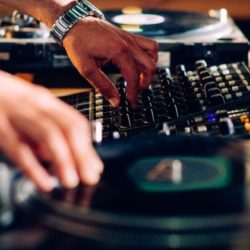There was a time when it was enough for a DJ to just be a talented music selector – simply purchase quality tunes and play them seamlessly to a discerning and eager dance floor audience. Each gig would lead to the next bigger and better gig. Opening slots and after hours gigs would eventually lead to the coveted time slots reserved for headlining DJs. Appearances on club flyers, occasional mixtapes and some simple social savvy, were all the side work a local DJ would need to do convince promoters to put them on the bill.
Those days are long gone. The job of a DJ has expanded into a multi-faceted occupation incorporating a conglomeration of tasks. Today, it’s the little things determining the success of the DJ just as much as the task of DJing itself.
Photos
Looking back to the ‘90s DJs seemed mysterious and enigmatic, faces masked by the flyer and the mixtape, and the word on the street. Word of mouth and the occasional unveiling of a press photo worked fine. Print press would rarely run DJ photos and seemed to focus on photos of dance floors with hands in the air. The advent of social media has changed that drastically and now even local DJs need top-notch photography in order to seem professional. But the need for high quality photos doesn’t stop at social media. Every label, PR company, magazine and promoter will need press photos to promote you, and it is with these photos you’ll create a first impression with the majority of your fanbase. My advice? Get new photos regularly and steer clear of cell phone shots. Do not under any circumstances use a selfie as a press shot (unless you are Burial). Make friends with photographers and try to amass a nice collection of photos for various promotional uses.
At a bare minimum, have five or six live shots and a few simple headshots with a background that is easy for a designer to knock out in Photoshop. If possible, it’s best to have your photos at a maximum resolution of 5” x 7”at 300 dpi in case your photo is used in print. The more photos you have, the better selection you, digital and print editors, and promoters all have to promote you with. Try to avoid redundancy.
Bio
Almost anyone who asks for a photo will also ask for a “bio” or biography. This bit of copy is used by writers and publicists who may not otherwise know who you are, to understand what to write about. If you are getting a feature in the local arts magazine, you can bet the writer will need to look over your bio. It’s important this information is well written, clear of grammatical errors and is an honest picture of you as an artist.
Just like your photos, your bio should be regularly updated to reflect what you are currently doing and it should be to the point. Typically, DJ bios outline the present and past of a DJ’s career and talk a little about where they are headed and what influences they have. Your bio should plug the projects you are working on, and the most important gigs you’ve played. It’s nice to have several versions of your bio on hand for various uses. Some publications just need a short paragraph, while others need something more. If you are using your bio to plug a release, it may not be important to include every DJ you’ve opened up for.
Charts
Almost every active touring DJ regularly turns in Top 10 charts to the various music shops, blogs and DJ magazines around the world (I’m pretty regular on Beatport). This information gets logged, recorded and looked at by the industry to help determine the success of the thousands of releases that hit the stores every day. The more a song appears on DJ charts, the longer shelf life that song will have, the better chance the release get featured, the better chance it will receive radio play. Your job as a DJ is crucial to the producers who spent painstaking hours writing the tunes and it’s your social obligation to pay it back to these artists by telling the world what songs you chose to play. But that’s not the only reason why it’s important for you as a DJ to turn in your charts.
Each time you turn in a DJ chart, your DJ name gets looked at and recorded by the industry, and it is that instance that helps verify you as an active DJ. Your peers will pay attention to this information, and often retweet and repost your charts to help spread the word that DJs are playing their tunes in the clubs. Think about it: when you turn in your charts, you are not only naming ten songs in your charts, but you are also naming ten record labels each with their own promotional engine to help spread the word and their music. Basically, the more you chart, the more important you are to the industry. So, who do you send these charts to? Anyone who will post them: online DJ record shops with a DJ chart section, any blogs that have DJ profiles and DJ culture magazines. Your local alternative weekly may run charts.
Regular Mixes
I can’t tell you how many times I’ve heard local DJs gripe about how tough it is to get gigs. When I ask them “When was the last time you shared a DJ mix?,” they reply with question marks and ellipses. It’s a bit of a no brainier, but deserves mentioning here, that without a current DJ demo, without charts, industry feedback, and without visibility, the last and only thing you have to present yourself as an artist is your word… and hopefully your good looks. If you are a DJ, do yourself a favor and set up an account on Soundcloud.com and share your DJ mixes with the world. If you can, replace them monthly with new mixes, and re-share them – not only with your friends and fans, but with the labels and artists who created the songs in your mix. Because again, sometimes these labels and artists will go on to share your feedback with the world, and that in turn, will translate to more visibility to you as a DJ.








Join the discussion
comments powered by Disqus